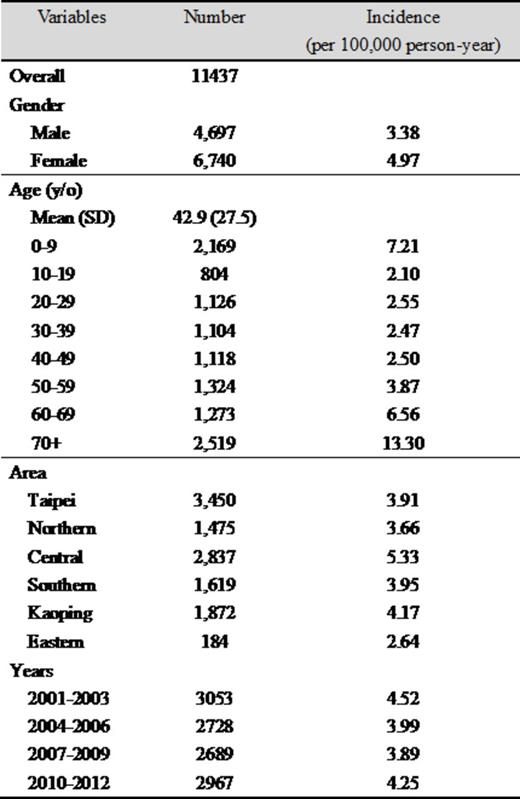Abstract

Background and Objectives
Immune thrombocytopenic purpura (ITP) is a rare disease, and the epidemiology and long-term outcome are still rarely characterized. This study is then aimed to provide a population-based assessment for the demographics and outcome about ITP in Taiwan, an island in Southeastern Asia with around 23 million inhabitants.
Material and Methods
This study used claims data from Taiwan's National Health Insurance Research Database (NHIRD). The database included information from a nationwide, mandatory-enrollment and single-payer healthcare system with more than 99% coverage rate in Taiwan since March, 1995.
To address adequate medical history tracking and outcome follow-up, only those patients with the first ITP diagnosis from Jan 1st, 2001 to Dec 31st, 2012 were included. Incident ITP was identified first with ICD-9 codes; but those cases with codes for potential ITP-confounding diseases within 6 months from the first ITP code were excluded. Next, only those patients with meaningful pharmacological treatment or splenectomy within 3 months were included in the final analysis.
Chronic ITP was defined for those with ICD-9 ITP codes and continuous drug exposure for more than 3 months, or with rituximab or splenectomy. Sex- and age-matched cohorts with 1:10 ratio were selected from Taiwan general population for survival comparison.
Results
Of the 30673 patients with ITP codes from Jan 1st, 2001 to Dec 31st, 2012, 11437 were identified as incident ITP. The mean age was 42.9+/-27.5 y/o, and 5445 (47.6%) cases had Charlson Comorbidity Index (CCI) score more than 2. The average incidence was 4.16 per 100,000 person-year, and the details are shown in Table 1. The incidence for female was higher than that for male (4.97 vs. 3.38 per 100,000 person-year), and the incidences across the age represented a U-shape distribution, with the highest ones in those aged 0-9 y/o and more than 70 y/o (7.21 and 13.3 per 100,000 person-year, respectively). Some geographic distribution of the incidences existed, with the highest in central part and the lowest in Eastern part of Taiwan (5.33 and 2.64 per 100,000 person-year, respectively).
Secondary causes could be identified in 3560 (31.0%) cases, and malignant neoplasma (1743, 49.0%) were most frequently noted. Viral hepatitis B or C were found in 785 (22.1%) cases. Chronic ITP was diagnosed during follow-up in 29.1% (n=3324) of incident ITP patients. Those incident ITP patients aged 0-9 y/o (431/2169 vs. 2893/9268, p<0.001) or male gender (1118/4697 vs. 2206/6740, p<0.001) had a less chance to develop chronic ITP.
As compared with the matched cohort from general population, the 10-yr survival rate was significantly inferior for all ITP patients, no matter in those aged below 20 y/o (96.9+/-0.5% vs. 98.8+/-0.1%, p<0.0001) or above 20 y/o (62.5+/-0.8% vs. 83.2+/-0.2%, p<0.0001), as in Figure 1. For chronic ITP, the disadvantaged 10-yr survival rates persisted (for age below 20 y/o: 96.5+/-1.0% vs. 98.6+/-0.2%, p<0.0001; for age above 20 y/o: 72.7+/-1.3% vs. 86.7+/-0.4%, p<0.0001, as in Figure 2). Elder age, male gender and high CCI scores predicted worse survival in multi-variate analysis.
Conclusions
This study is the largest population-based epidemiology report at nationwide scale till now. Not only the results can provide a valuable demographic description for ITP in Eastern Asia, but also they confirm an inferior long-term outcome for ITP patients, which necessitates more attention to their health care.
SD: standard deviation
Tang:Novartis: Consultancy, Honoraria.
Author notes
Asterisk with author names denotes non-ASH members.

This icon denotes a clinically relevant abstract




This feature is available to Subscribers Only
Sign In or Create an Account Close Modal